Abstract
1. We determined the kinetics of cardiac output (Q) with respect to oxygen uptake (VO2) at the on- and off-transients of constant-load exercise. Six subjects performed constant-load exercise which consisted of 5 min rest, 5 min one-legged pedalling at 50 W and a 5 min recovery period. 2. The transient responses were characterized by first-order kinetics. There was no significant difference between the time constants for VO2 (tau VO2) at the on- (33.9 +/- 3.5 s, mean +/- S.E.M.) and off-transient (37.2 +/- 2.9 s). The time constant for Q (tau Q, 29.4 +/- 3.2 s) was consistently shorter than tau VO2 at the on-transient. However, tau Q was appreciably longer at the off-transient (44.3 +/- 3.6 s) than the on-transient. 3. The results support the contention that the time constant for the on-transient of Q is appreciably faster than that for VO2 and hence there seems little justification for the notion that the time constants for the kinetics of VO2 are determined by the limitations of blood flow in the transient. The asymmetry of Q kinetics, with the off-transient tau Q being appreciably slower than the on-transient tau Q, serves to maintain a sufficiently high oxygen flow to the muscle during recovery from exercise at a time when the muscle oxygen uptake remains high.
Full text
PDF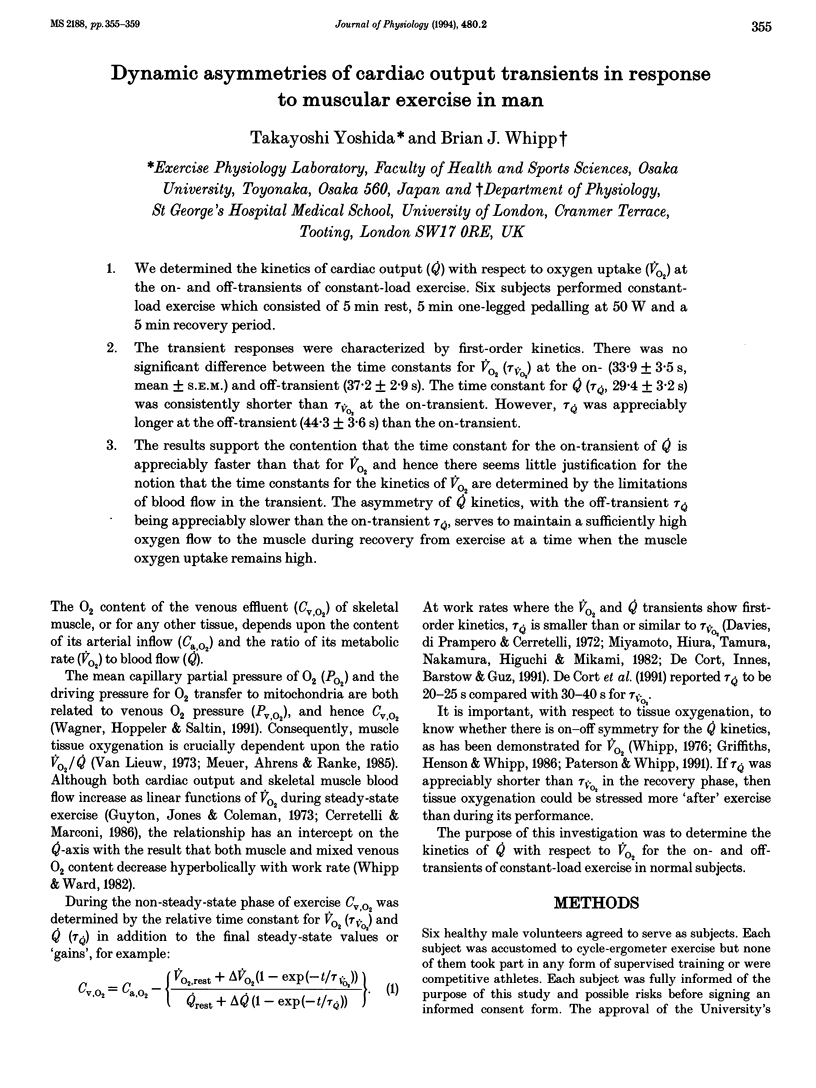
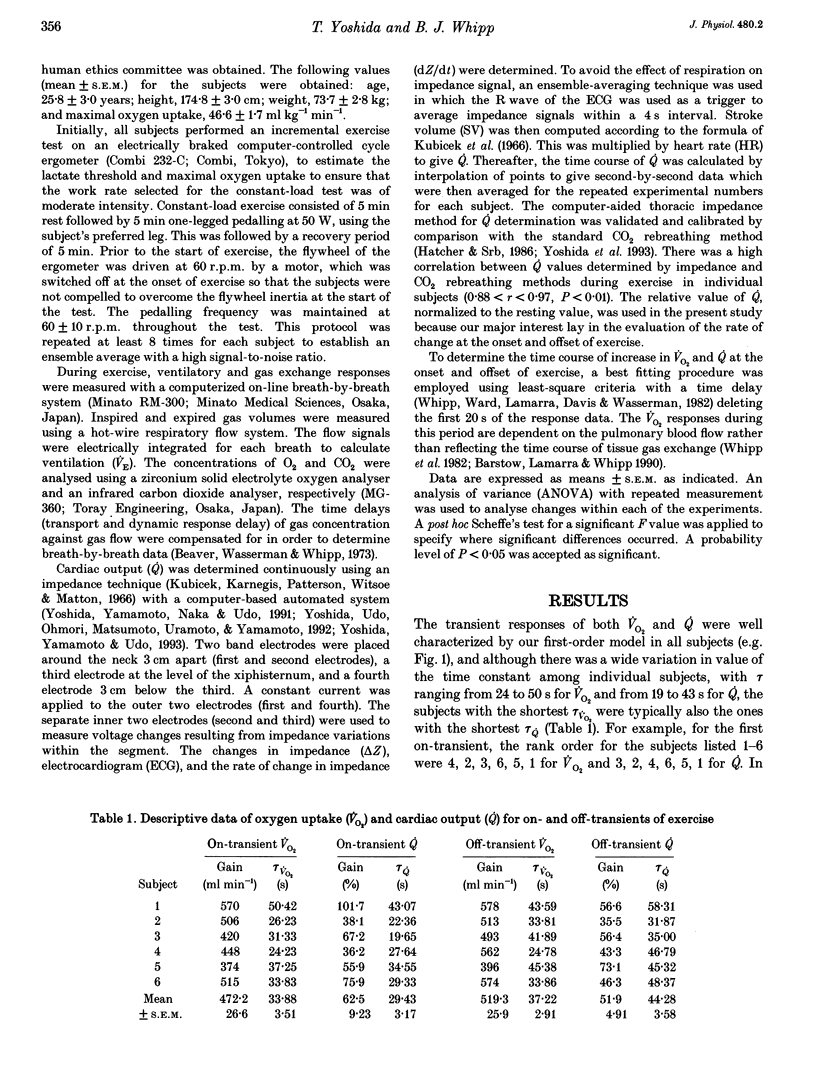
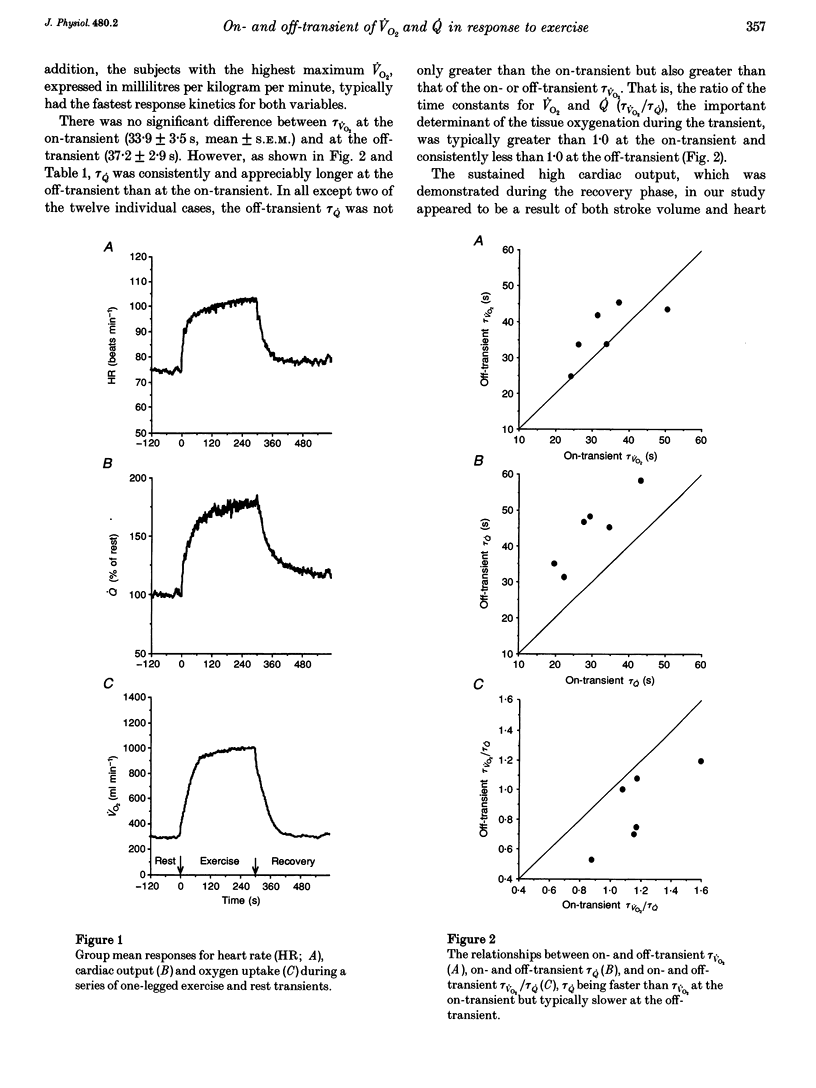
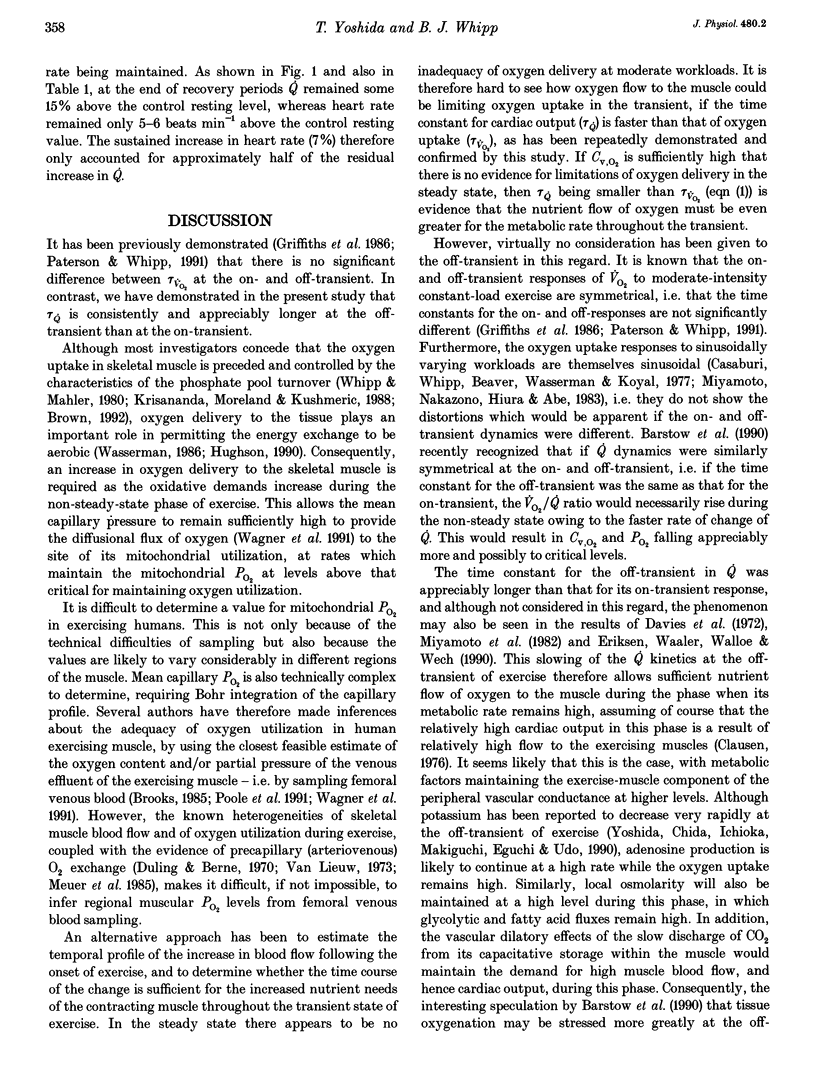
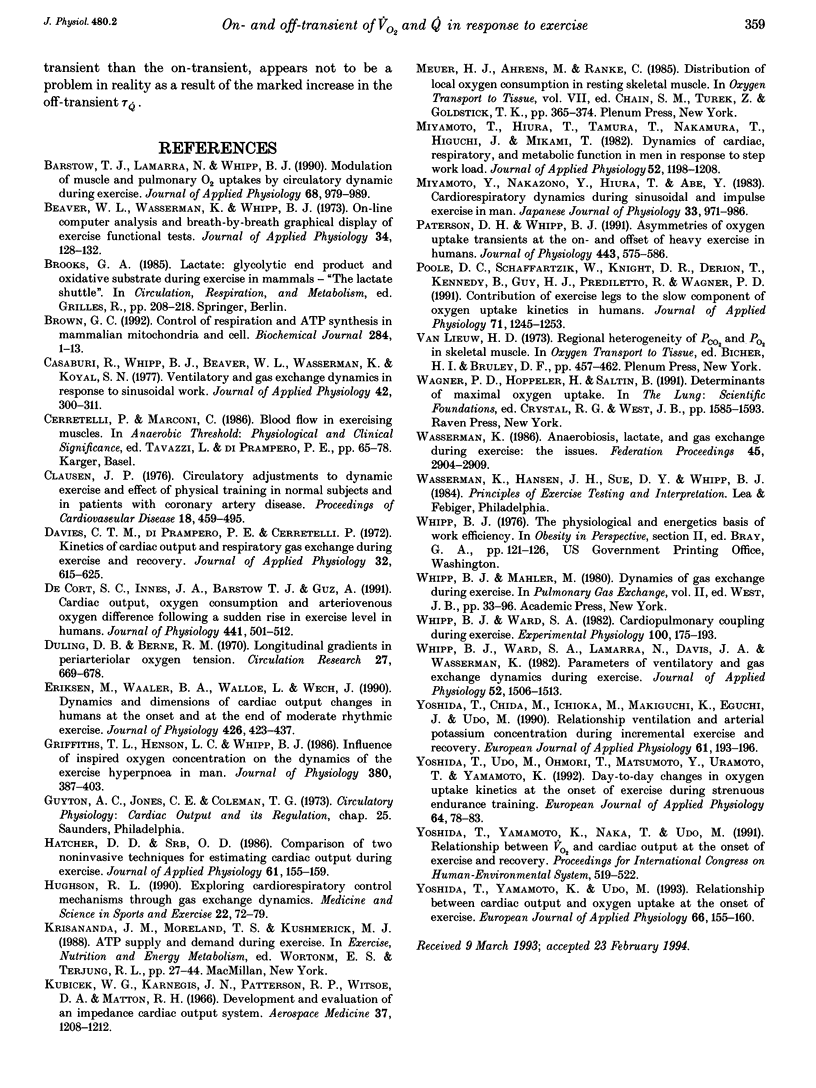
Selected References
These references are in PubMed. This may not be the complete list of references from this article.
- Barstow T. J., Lamarra N., Whipp B. J. Modulation of muscle and pulmonary O2 uptakes by circulatory dynamics during exercise. J Appl Physiol (1985) 1990 Mar;68(3):979–989. doi: 10.1152/jappl.1990.68.3.979. [DOI] [PubMed] [Google Scholar]
- Beaver W. L., Wasserman K., Whipp B. J. On-line computer analysis and breath-by-breath graphical display of exercise function tests. J Appl Physiol. 1973 Jan;34(1):128–132. doi: 10.1152/jappl.1973.34.1.128. [DOI] [PubMed] [Google Scholar]
- Brown G. C. Control of respiration and ATP synthesis in mammalian mitochondria and cells. Biochem J. 1992 May 15;284(Pt 1):1–13. doi: 10.1042/bj2840001. [DOI] [PMC free article] [PubMed] [Google Scholar]
- Casaburi R., Whipp B. J., Wasserman K., Beaver W. L., Koyal S. N. Ventilatory and gas exchange dynamics in response to sinusoidal work. J Appl Physiol Respir Environ Exerc Physiol. 1977 Feb;42(2):300–301. doi: 10.1152/jappl.1977.42.2.300. [DOI] [PubMed] [Google Scholar]
- Clausen J. P. Circulatory adjustments to dynamic exercise and effect of physical training in normal subjects and in patients with coronary artery disease. Prog Cardiovasc Dis. 1976 May-Jun;18(6):459–495. doi: 10.1016/0033-0620(76)90012-8. [DOI] [PubMed] [Google Scholar]
- Davies C. T., Di Prampero P. E., Cerretelli P. Kinetics of cardiac output and respiratory gas exchange during exercise and recovery. J Appl Physiol. 1972 May;32(5):618–625. doi: 10.1152/jappl.1972.32.5.618. [DOI] [PubMed] [Google Scholar]
- De Cort S. C., Innes J. A., Barstow T. J., Guz A. Cardiac output, oxygen consumption and arteriovenous oxygen difference following a sudden rise in exercise level in humans. J Physiol. 1991 Sep;441:501–512. doi: 10.1113/jphysiol.1991.sp018764. [DOI] [PMC free article] [PubMed] [Google Scholar]
- Duling B. R., Berne R. M. Longitudinal gradients in periarteriolar oxygen tension. A possible mechanism for the participation of oxygen in local regulation of blood flow. Circ Res. 1970 Nov;27(5):669–678. doi: 10.1161/01.res.27.5.669. [DOI] [PubMed] [Google Scholar]
- Eriksen M., Waaler B. A., Walløe L., Wesche J. Dynamics and dimensions of cardiac output changes in humans at the onset and at the end of moderate rhythmic exercise. J Physiol. 1990 Jul;426:423–437. doi: 10.1113/jphysiol.1990.sp018147. [DOI] [PMC free article] [PubMed] [Google Scholar]
- Griffiths T. L., Henson L. C., Whipp B. J. Influence of inspired oxygen concentration on the dynamics of the exercise hyperpnoea in man. J Physiol. 1986 Nov;380:387–403. doi: 10.1113/jphysiol.1986.sp016292. [DOI] [PMC free article] [PubMed] [Google Scholar]
- Hatcher D. D., Srb O. D. Comparison of two noninvasive techniques for estimating cardiac output during exercise. J Appl Physiol (1985) 1986 Jul;61(1):155–159. doi: 10.1152/jappl.1986.61.1.155. [DOI] [PubMed] [Google Scholar]
- Hughson R. L. Exploring cardiorespiratory control mechanisms through gas exchange dynamics. Med Sci Sports Exerc. 1990 Feb;22(1):72–79. [PubMed] [Google Scholar]
- Kubicek W. G., Karnegis J. N., Patterson R. P., Witsoe D. A., Mattson R. H. Development and evaluation of an impedance cardiac output system. Aerosp Med. 1966 Dec;37(12):1208–1212. [PubMed] [Google Scholar]
- Meuer H. J., Ahrens M., Ranke C. Distribution of local oxygen consumption in resting skeletal muscle. Adv Exp Med Biol. 1985;191:365–374. doi: 10.1007/978-1-4684-3291-6_37. [DOI] [PubMed] [Google Scholar]
- Miyamoto Y., Hiura T., Tamura T., Nakamura T., Higuchi J., Mikami T. Dynamics of cardiac, respiratory, and metabolic function in men in response to step work load. J Appl Physiol Respir Environ Exerc Physiol. 1982 May;52(5):1198–1208. doi: 10.1152/jappl.1982.52.5.1198. [DOI] [PubMed] [Google Scholar]
- Miyamoto Y., Nakazono Y., Hiura T., Abe Y. Cardiorespiratory dynamics during sinusoidal and impulse exercise in man. Jpn J Physiol. 1983;33(6):971–986. doi: 10.2170/jjphysiol.33.971. [DOI] [PubMed] [Google Scholar]
- Paterson D. H., Whipp B. J. Asymmetries of oxygen uptake transients at the on- and offset of heavy exercise in humans. J Physiol. 1991 Nov;443:575–586. doi: 10.1113/jphysiol.1991.sp018852. [DOI] [PMC free article] [PubMed] [Google Scholar]
- Poole D. C., Schaffartzik W., Knight D. R., Derion T., Kennedy B., Guy H. J., Prediletto R., Wagner P. D. Contribution of exercising legs to the slow component of oxygen uptake kinetics in humans. J Appl Physiol (1985) 1991 Oct;71(4):1245–1260. doi: 10.1152/jappl.1991.71.4.1245. [DOI] [PubMed] [Google Scholar]
- Wasserman K. Anaerobiosis, lactate, and gas exchange during exercise: the issues. Fed Proc. 1986 Dec;45(13):2904–2909. [PubMed] [Google Scholar]
- Whipp B. J., Ward S. A. Cardiopulmonary coupling during exercise. J Exp Biol. 1982 Oct;100:175–193. doi: 10.1242/jeb.100.1.175. [DOI] [PubMed] [Google Scholar]
- Whipp B. J., Ward S. A., Lamarra N., Davis J. A., Wasserman K. Parameters of ventilatory and gas exchange dynamics during exercise. J Appl Physiol Respir Environ Exerc Physiol. 1982 Jun;52(6):1506–1513. doi: 10.1152/jappl.1982.52.6.1506. [DOI] [PubMed] [Google Scholar]
- Yoshida T., Chida M., Ichioka M., Makiguchi K., Eguchi J., Udo M. Relationship between ventilation and arterial potassium concentration during incremental exercise and recovery. Eur J Appl Physiol Occup Physiol. 1990;61(3-4):193–196. doi: 10.1007/BF00357598. [DOI] [PubMed] [Google Scholar]
- Yoshida T., Udo M., Ohmori T., Matsumoto Y., Uramoto T., Yamamoto K. Day-to-day changes in oxygen uptake kinetics at the onset of exercise during strenuous endurance training. Eur J Appl Physiol Occup Physiol. 1992;64(1):78–83. doi: 10.1007/BF00376445. [DOI] [PubMed] [Google Scholar]
- Yoshida T., Yamamoto K., Udo M. Relationship between cardiac output and oxygen uptake at the onset of exercise. Eur J Appl Physiol Occup Physiol. 1993;66(2):155–160. doi: 10.1007/BF01427057. [DOI] [PubMed] [Google Scholar]


